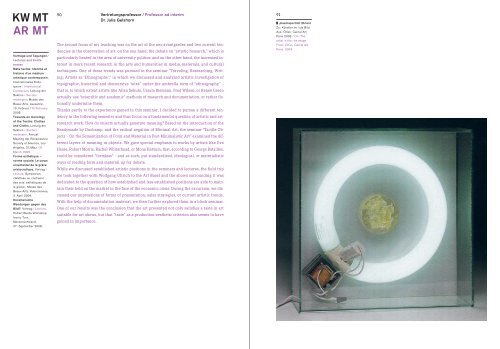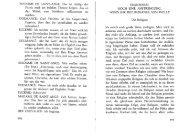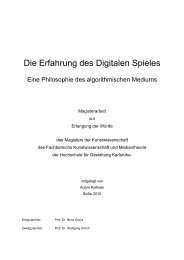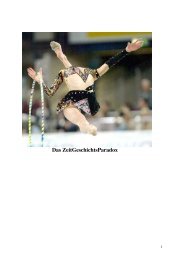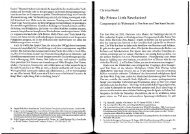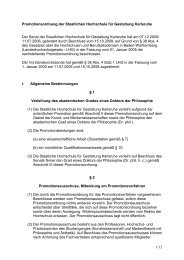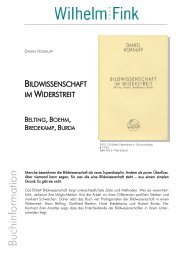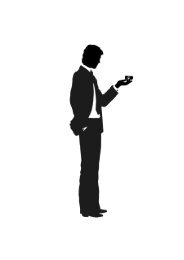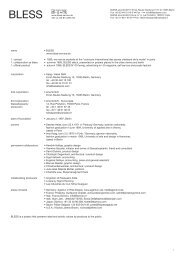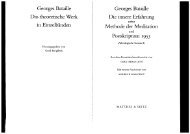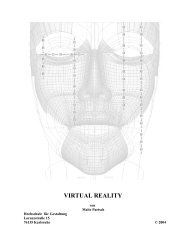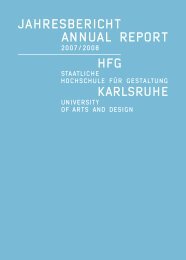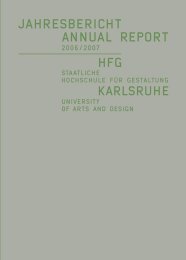HfG Karlsruhe Jahresbericht Staatliche Hochschule für Gestaltung ...
HfG Karlsruhe Jahresbericht Staatliche Hochschule für Gestaltung ...
HfG Karlsruhe Jahresbericht Staatliche Hochschule für Gestaltung ...
Erfolgreiche ePaper selbst erstellen
Machen Sie aus Ihren PDF Publikationen ein blätterbares Flipbook mit unserer einzigartigen Google optimierten e-Paper Software.
KW MT<br />
AR MT<br />
Vorträge und Tagungen/<br />
Lectures and Conferences<br />
Méta-textile: Identité et<br />
histoire d’un médium<br />
artistique contemporain,<br />
Internationales Kolloquium<br />
/ International<br />
Colloquium, Leitung der<br />
Sektion / Section<br />
moderator, Musée des<br />
Beaux-Arts, Lausanne,<br />
13. Februar /13 February<br />
2009.<br />
Towards an Iconology<br />
of the Textile: Clothes<br />
and Cloths, Leitung der<br />
Sektion / Section<br />
moderator, Annual<br />
Meeting der Renaissance<br />
Society of America, Los<br />
Angeles, 21. März / 21<br />
March, 2009.<br />
Forme esthétique –<br />
norme sociale. Le corps<br />
ornemental de la grâce<br />
aristocratique, Vortrag /<br />
Lecture, Symposium<br />
»Watteau au confluent<br />
des arts: esthétiques de<br />
la grâce«, Musée des<br />
Beaux-Arts, Valenciennes,<br />
3. April 2009.<br />
Künstlerische<br />
Wendungen gegen das<br />
Bild?, Vortrag / Lecture,<br />
Hubert Burda-Workshop<br />
Iconic Turn,<br />
Menzenschwand,<br />
27. September 2008.<br />
90 Vertretungsprofessor / Professor ad interim<br />
Dr. Julia Gelshorn<br />
91<br />
The second focus of my teaching was on the art of the neo-avantgardes and two current tendencies<br />
in the observation of art: on the one hand, the debate on “artistic research,” which is<br />
particularly heated in the area of university politics; and on the other hand, the increased interest<br />
in more recent research in the arts and humanities in media, materials, and cultural<br />
techniques. One of these trends was pursued in the seminar “Traveling, Researching, Writing;<br />
Artists as ‘Ethnographs’,” in which we discussed and analyzed artistic investigation of<br />
topographic, historical and discoursive “sites” under the umbrella term of “ethnography” --<br />
that is, to which extent artists like Allan Sekula, Ursula Biemann, Fred Wilson, or Renée Green<br />
actually use “scientific and academic” methods of research and documentation, or rather fictionally<br />
undermine them.<br />
Thanks partly to the experience gained in this seminar, I decided to pursue a different tendency<br />
in the following semester and thus focus on a fundamental question of artistic and artresearch<br />
work: How do objects actually generate meaning? Based on the introduction of the<br />
Readymade by Duchamp, and the radical negation of Minimal Art, the seminar “Tactile Objects<br />
– On the Semantization of Form and Material in Post-Minimalistic Art” examined the different<br />
layers of meaning in objects. We gave special emphasis to works by artists like Eva<br />
Hesse, Robert Morris, Rachel Whiterhead, or Mona Hatoum, that, according to George Batailles,<br />
could be considered “formless” -- and as such, put standardized, ideological, or materialistic<br />
ways of reading form and material up for debate.<br />
While we discussed established artistic positions in the seminars and lectures, the field trip<br />
we took together with Wolfgang Ullrich to the Art Basel and the shows surrounding it was<br />
dedicated to the question of how established and less-established positions are able to maintain<br />
their hold on the market in the face of the economic crisis. During the excursion, we discussed<br />
our impressions of forms of presentation, sales strategies, or current artistic trends.<br />
With the help of documentation material, we then further explored them in a block seminar.<br />
One of our results was the conclusion that the art presented not only satisfies a taste in art<br />
suitable for art shows, but that “taste” as a production-aesthetic criterion also seems to have<br />
gained in importance.<br />
█ plasmaporträt (Orlan)<br />
Zu: Künstler im / als Bild<br />
Aus: Orlan. Carnal Art,<br />
Paris 2003 / On: The<br />
artist in the / as image<br />
From: Orlan. Carnal Art,<br />
Paris, 2003


